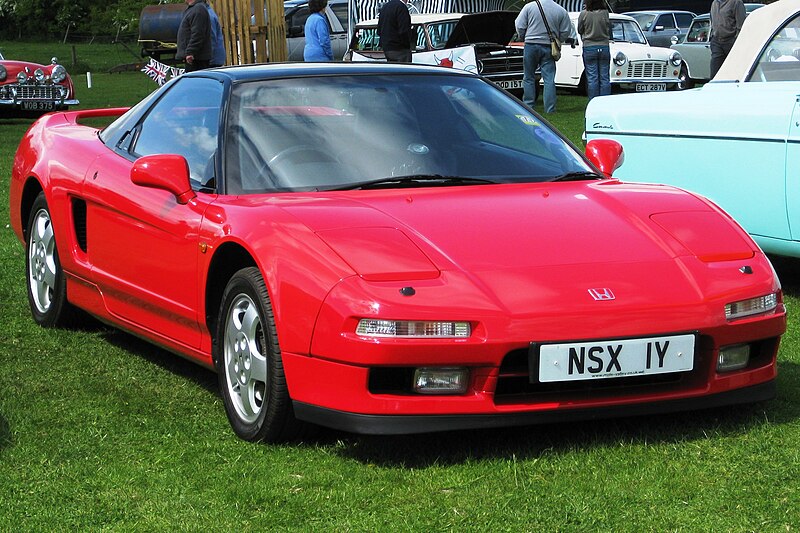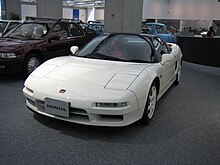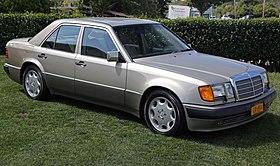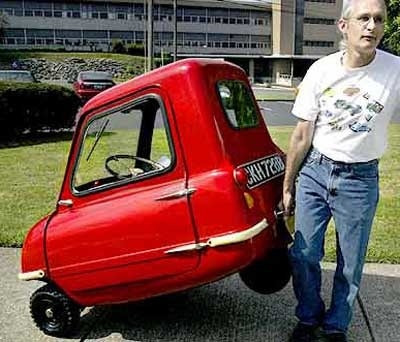A laundry list of car reviews, opinion pieces, technical articles and curated articles just for you!
Showing posts with label Classic Cars. Show all posts
Showing posts with label Classic Cars. Show all posts
11 May 2016
5 May 2016
Honda NSX
 |
| Source: https://commons.wikimedia.org/wiki/File:Honda_NSX_reg_1991_2977_cc.JPG |
What do you get if you take a Honda with Pininfarina-designed body panel and inject sporty DNA into it's vein to challenge the likes of Ferrari? The answer is the Honda NSX. Though it went into production in 1990, it's development began in 1984.
Tracing it's root back to 1984, Honda approached Pininfarina, an Italian coachbuilder, to commission the HP-X (Honda Pininfarina eXperimental) concept with a 2 litre V6 engine mounted amidship.
| Source: http://www.topspeed.com/cars/honda/1990-2005-honda-nsx-ar1449.html |
During it's development period, the Honda management figured they could create a supercar that rivals the performance of the Ferrari while offering stellar reliability and lower price tag. As a result, the HP-X concept evolved into the NSX (New Sportscar eXperimental).
Honda set the Ferrari 348 as a benchmark. To fulfill Honda's vision to put the 348 to shame, out goes the 2 litre V6 from the concept and in goes a more powerful mid-mounted transverse 3 litre VTEC DOHC V6 with a variable length intake manifold that churned out 270 bhp to the rear wheels via a 5 speed manual. The use of titanium connecting rod further optimised the output of the 'Ferrari burner'.
In the chassis department, the Honda engineers received a helping hand from the late triple F1 champion, Ayrton Senna who clinched the 1988, 1990 and 1991 title driving for the McLaren Honda team. Thanks to his input, the NSX chassis gained the much needed rigidity, and much beefier double wishbone suspension all-round, endowing Honda's answer to Ferrari with an impressive cornering speed.
Weight reduction played a crucial role to the NSX's quest to demonstrate its performance credibility. This called for aluminium body panel and aluminium suspension arms. The extensive use of aluminium endowed the NSX with a curb weight of 1370 kg.
 |
| Source: https://en.wikipedia.org/wiki/Honda_NSX_(first_generation)#1992_NSX-R_.28Japanese_domestic_market.29 |
Throughout it's production run from 1990-2005, the NSX had gone through several upgrades. Most notably was when the first iteration of the NSX-Type R, or NSX-R, was rolled out the assembly line in 1992 featuring a much larger, more powerful 3.2 litre V6 tuned by Mugen, extensive weight reduction, extra beefy suspension and a more aggressive final drive ratio up to 4.235:1 from the stock 4.06:1 for eyeball-popping acceleration. In 2002, the NSX Type R received a facelift which saw the introduction of carbon fibre to further cut weight and boosting power via engine tweaking. The result is a Nurburgring lap time of 7:56 rivalling the Ferrari F360 Challenge Stradale, set by a former Japanese racing driver and current Best Motoring presenter, Motoharu Kurosawa.
To this writer, the NSX is Honda's stepping stone to challenge the European performance icon. The recently launched second generation NSX with it's new powertrain represents the stride Honda has made to become a major player in the high performance car industry.
21 Jan 2016
Mercedes Benz 500 E
 |
| Source: wikipedia.com |
At times of tight financial, Porsche faced a conundrum: drop in sales. What Mercedes got anything to do with it? Well, it had nothing to do with the drop in sales, but rather Porsche knocked at Mercedes door to strike a deal to help them in manufacturing the performance version of Mercedes W124 sedan, known as the 500E. Though still bearing the 3 pointed-star badge, this sleeper is essentially a Mercedes with Porsche's fingerprint.
Though Mercedes had a say on what had to be done to the car, it was Porsche who worked their magic in assembling the mechanical bits.
Plonked under the bonnet was a 5 litre naturally aspirated V8 which was fished out from the 500SL roadster and dropped off at Rossle Bau for Porsche to plonk it into the 500E engine bay; the rear suspension received upgrade from Porsche. While the gaffes at Rossle Bau busied themselves with the technicals, Mercedes dealt their deft touch with a coat of paint. Finally, the car was shuttled back to Porsche for the final assembly.
Plonked under the bonnet was a 5 litre naturally aspirated V8 which was fished out from the 500SL roadster and dropped off at Rossle Bau for Porsche to plonk it into the 500E engine bay; the rear suspension received upgrade from Porsche. While the gaffes at Rossle Bau busied themselves with the technicals, Mercedes dealt their deft touch with a coat of paint. Finally, the car was shuttled back to Porsche for the final assembly.
The result? A bonkers fast performance sedan that can rip off the tarmac with aplomb (well, not literally) to satisfy the need for speed amongst the testosterone-laden hamfisted hooligans (326 worth of ponies, not bad sir!), while its leather-trimmed seats made for a comfortable cruiser (good for a family day out, or for excursion to a fancy restaurant with your significant others).
Luxurious from the outside, a fire-breathing dragon sleeping underneath waiting to unleash its wrath, a dragon in tuxedo skin.
19 Jan 2016
Porsche 959
Introduced during the 1983 IAA (Frankfurt International Auto Show), this beast called the 959 was intended to be a homologation special for participation into the FIA Group B racing (already defunct since 1986 due to being ungodly dangerously fast) with at least 200 examples of road going version to be built. Nevertheless, anyone lucky enough to own this marvelous piece of machinery will have the liberty to stretch its legs in their grandpa's favourite twisties, or show off Senna-esque 'win at all cost' on god forbid the most Frankestein monster of a race track (Nordschleife we are looking at you).
This car is everything that Porsche can do to augment the taste, the flight of fancy that every 911 owners could dream of. Yes folks, the 959 is basically a 911 with some bonkers going on under the skin, making it arguably Porsche's first true supercar, outfitted with state-of-the-art niceties for its time (mind you, this beast was produced in the late 80s).
| Source: silodrome.com |
All those powers are channeled to a six speed manual transmission and permanent all-wheel drive with driver-selectable driving programs to ensure all those insane powers will keep you from flying off the cliff.
As always in performance realm, going on a diet is the holy grail in translating those huge powers into whatever performance figures that anoraks cherish. The doors and hood for instance, were made of aluminium and the rest of the body was Kevlar-reinforced fibreglass.
The 959 was offered in two trims: sports and comfort. Choose the sports trim, you will have to make do without air-conditioning, power windows and seats, back seats and adjustable ride height control in the name of weight savings. Choose the comfort trim, you have the aforementioned niceties equipped but at the expense of increase weight, but if go-fast is not your thing then this is the trim to choose.
The 959 was offered in two trims: sports and comfort. Choose the sports trim, you will have to make do without air-conditioning, power windows and seats, back seats and adjustable ride height control in the name of weight savings. Choose the comfort trim, you have the aforementioned niceties equipped but at the expense of increase weight, but if go-fast is not your thing then this is the trim to choose.
| Source: auto.howstuffworks.com |
To those who own a 911 or have 911 as their 'cover girl', the 959 is an incredible boost for the 911 experience, with the added performance to put the standard 911 to shame. All in all, the 959 is not a wannabe 911 with 911 cosmetic enhancement per se, but a 911 that will make you clamour for it.
Subscribe to:
Comments
(
Atom
)

